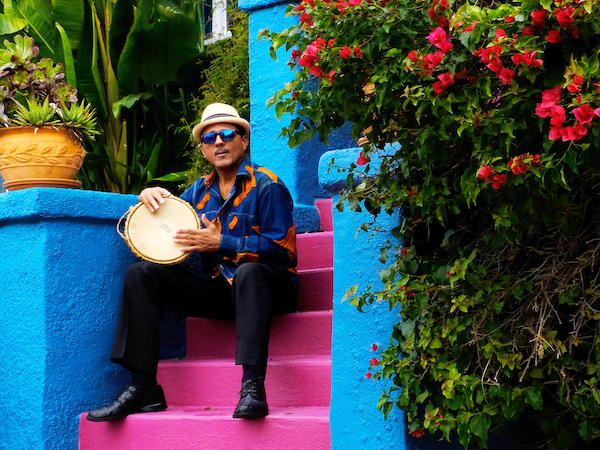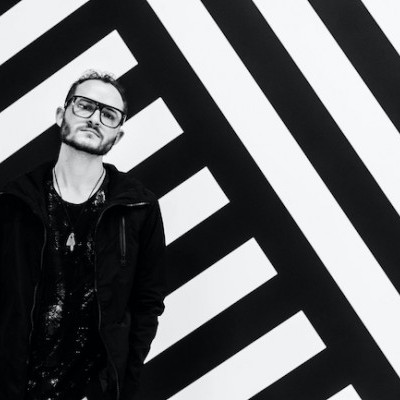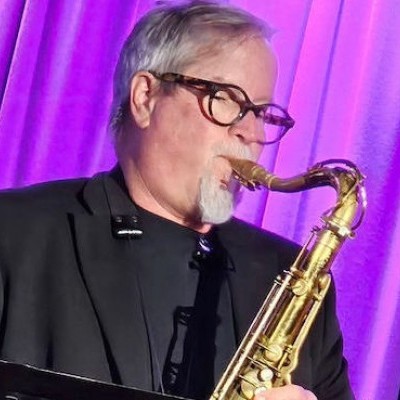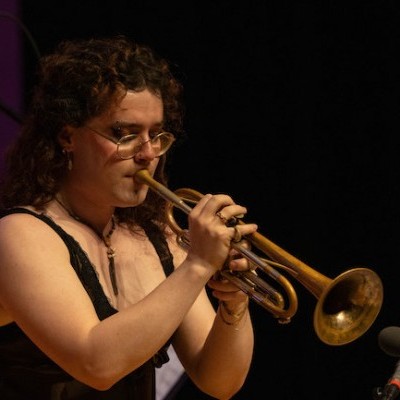Oct 28, 2025 10:47 AM
In Memoriam: Jack DeJohnette, 1942–2025
Jack DeJohnette, a bold and resourceful drummer and NEA Jazz Master who forged a unique vocabulary on the kit over his…

Percussionist and bandleader John Santos has a foundation in what he refers to as “traditional” music, but he has played and recorded with figures from across the spectrum of Latin music, jazz and rock.
(Photo: Michael G. Stewart)The day before Joe Biden was sworn into office as president on Jan. 20, John Santos, ensconced in his East Bay home since the 1990s, went to get his mail. The 65-year-old percussionist found an envelope without a return address, and inside was a note thanking him for decades of music—along with a wad of cash.
The letter was unsigned.
Beginning in mid-’70s San Francisco, Santos carved out a career predicated on thoughtful ruminations around drumming, how percussion functions in culture and music, and how those ideas have changed, while managing to persistently tell the story of the people who played the instruments. His oeuvre is an ouroboros of development, the past feeding the present and generating new ideas and inspiration for the future. While Art Of The Descarga (Smithsonian Folkways) was recorded between 2011 and 2015, the music only saw the light of day last year, as the pandemic lockdown added resonance to the bandleader’s examination of generational change.
Santos’ journey started in the homes of his extended family, where he attended impromptu jams, and extended through his leadership of Machete Ensemble, Orquesta Batachanga and a handful of other troupes, including the sextet he helms on Descarga.
One tune on the album, “Plena Vida,” extolls the virtues of a specific Puerto Rican rhythm, while “Tumbao De Corazon’’ reflects a broader berth, examining Afro-Caribbean music. But folk traditions from across North and South American are included here, with the Santos band displaying not just its depth of knowledge, but a genuine desire to provide a rhythmically acute historical document.
Even as the pandemic might have muted the impact of Art Of The Descarga upon its release, Santos—who recently spoke to DownBeat over Zoom about the expansion of genre expectations around Latin jazz, change and solidarity—is planning to release Filosofía Caribeña, Vol. 3 later this year.
The following has been edited for length and clarity.
You’ve frequently talked about the political function of drumming. How do you think percussion was used during the Trump years and specifically during the pandemic?
I think the role that they play in the community was more urgent than ever during the Trump era. The repression, the backlash—so to speak—against everything that the drum represents is more intense now. So, the role hasn’t changed; it’s always been important for the drum to have its voice out there and be accompanying the movement, the poetry and the lyrics, and the sentiment of the movement. The drums and rhythm is a big part of that.
It’s true all over the Americas: The drum surfaces in so many ways—and in a more general sense, of course, all that the drum represents in the tradition. My family comes from Puerto Rico, and in Puerto Rico, we have plena. The plena is a style of Afro-Puerto Rican music that has its roots in protest. It comes out of the workers movement—cane cutters. It’s played with frame drums, handheld drums. And because it’s so easy to carry, at every protest or any kind of a manifestation in the streets by the workers, they always have the plena there, always without exception.
So, we’re used to the idea of having rhythm and having one of our most beloved traditional rhythms—arguably the most beloved rhythm in Puerto Rico—as part of the movement for justice and the fight for equality. It’s part and parcel. Of course, the bomba is the most African style, and that goes back to the colonial period. That’s a big part of what we do. And we use those rhythms and those drums in contemporary music; I use that rhythm. We have one song on [Descarga] that’s totally based on that rhythm.
You’ve been an advocate for a range of different music during the past 40 years, and each one of the songs on Descarga is labeled with the rhythm that you use. How much of your work has an educational aspect to it?
It’s amazing, because it’s all about education. The role of music—and the role of art in general—it’s always been the most important tool of education. It comes from the oral tradition—the way, for centuries, how everything was transmitted. From the knowledge of how to be in the world to the ethics and morals of the community, they’re all transmitted orally. So, poetry and music and the choreography, the dancing—all of that—it goes hand in hand with the idea of educating a new generation, passing on information.
For me, it happened early on, because I started playing this kind of music when I was about 11 years old. I grew up with it, from the time I was born. But when I was about 11, I joined my grandfather’s band. So, I was around elders, and I had the experience of getting it passed down orally, because none of those musicians read [music]. They were all self-taught and played by ear. But they had a lot of experience, a lot of stories and things to say.
When they see a young person taking an interest, they really take you under their wing, and they share with you what’s going on and they show you the ropes. So, I appreciated that from early on—learning about the history. I learned how to speak Spanish through those songs and finding out what the songs are about. And they’re incredible: They’re about love, but they’re also about the people’s conditions and their social reality. And that’s the only thing that existed like that.
Descarga seems much more jazz influenced than some of your other work. What was that a result of?
It’s not a new thing for us. It’s the fact that everything we do is coming from the same space: this Afro-root in the Caribbean. And that includes jazz, because jazz is so much a part of that. There’s nothing more Caribbean than jazz, and jazz has always been part of our tradition in Puerto Rico, in Cuba, in Brazil. So, we’ve been listening to jazz the whole time, you know?
My parents were great jazz fans and had a great record collection. A big part of my collection here is jazz, and I grew up listening to it. I got a chance to meet some of the pioneers who brought bebop and Cuban music together. Dizzy Gillespie and Max Roach, I got to play with them, and I recorded with Dizzy. We’ve always had a jazz element and we’ve always included jazz in what we’ve done.
On this particular record, there may have been a little bit more of it. Maybe because I’m working now for the past couple years with a sextet, the instrumentation is more conducive to doing jazz stuff. We’ve had a bunch of singers and a different kind of approach, but we’ve always done all [kinds of music]. On every single record I’ve done, there’s going to be an element of jazz, of Cuba, of Puerto Rico, of dance music, of experimental music. We’ve really tried not to limit it. ... We really have an open palette and have taken advantage of it. I want to show that the music is multidimensional and present it in all its colors.
The term “jazz” means 10 different things to 10 different people. Have you seen the concept of “Latin jazz” change or expand during your career?
Oh, certainly, it’s expanded. The music is always expanding, constantly in flux. Yet the roots are still firm. That’s the beauty of it: Musicians have always been against pigeonholing it for the industry’s sake—or to know what bin to put the record in. There’s always been disparate sides of jazz and of Latin jazz. Tito Puente was a pioneer and he always said it had to be danceable to be Latin jazz. But one of his contemporaries—Ray Barretto, who used to play in Tito’s band—would say, “If it’s danceable, it’s salsa. Latin jazz is something else.” He looked at it differently, and they were certainly both legitimate perspectives.
Nowadays, there’s still a lot of great danceable Latin jazz put out by these big bands—Spanish Harlem Orchestra, Poncho Sanchez and many others. And then there’s more experimental stuff, more cutting edge, I would say, like Miguel Zenón, Yosvany Terry. And they’re less interested in playing dance music, although they do a lot of dance rhythms. It’s more about the experimental part and putting no limits on it—harmonically and melodically or time signature-wise, not feeling like you have to play a mambo or cha-cha-cha. Doing stuff in odd meter, that’s something that’s more and more prevalent now.
Given that kind of expansion, here’s an unfair question: Seeing how you’ve regularly led four or five different bands, is one of those groups representative of the music you hear in your head?
There’s not one answer for that, because what I hear in my head is so disparate. It’s such a wide range of stuff. I would say that the group I led for 21 years was the main group. The Machete Ensemble, I think, was ideal because—throughout the whole 21 years, but especially in the first 10 years—it was a big group and it allowed me to do more. It was a group that would have five and sometimes more horns. It would have sometimes three, four, five or more singers. It would sometimes have four or five percussionists. It was just a huge group, so we could do anything.
The economic reality forced me to downsize. And so, the group that I’ve had for the past several years is a sextet, and I love it. I love the group and what we’ve been able to do. But you’ll notice on all of our records, we’ve recorded as a quintet and a sextet over the last 15 years, and on none of them are there less than 25 musicians. I’ve always gotten all these guests. I hear that bigger sound for a lot of stuff. But it’s fun and challenging to write and play with a smaller group; a lot more responsibility falls on each musician, especially me as a percussionist. I could float and come in and out and stop playing whenever I wanted to when the band was big. But now, I have a lot more responsibility to keep the rhythm and be a more solid player.
At a time when I’m getting older, it’s a bit tricky to keep up, because my instrument is a very physical one. And it’s evolved in such a way that the best players now are like Olympic athletes the way that they play. It’s beautiful. It’s a challenge, I love it. But Machete Ensemble at that time, we were doing the most varied music, because we had that instrumentation to work with. But it doesn’t stop me, and if I need violins or more horns or more percussionists or singers, I bring them in. DB

Jack DeJohnette boasted a musical resume that was as long as it was fearsome.
Oct 28, 2025 10:47 AM
Jack DeJohnette, a bold and resourceful drummer and NEA Jazz Master who forged a unique vocabulary on the kit over his…

“I’ve told students, ‘I don’t mind if you use AI for this or that project,’” says MIT’s Pascal Le Boeuf. “‘But you need to tell me.’”
Sep 18, 2025 11:14 AM
A standard joke when it comes to discussing artificial intelligence, or AI, is that it’s developing so rapidly that…

Chuck Manning Works for NASA … and plays jazz.
Sep 18, 2025 11:23 AM
Congratulations! After years of study, you’ve earned your degree in jazz performance. But let’s face it: Making a…

Always a sharp dresser, Farnsworth wears a pocket square given to him by trumpeter Art Farmer. “You need to look good if you want to hang around me,” Farmer told him.
Sep 23, 2025 11:12 AM
When he was 12 years old, the hard-swinging veteran drummer Joe Farnsworth had a fateful encounter with his idol Max…

“Make time and energy to meet people and make friends,” suggests Millie Ahearn, a student at DePaul University.
Sep 18, 2025 11:32 AM
For many students, the transition into a collegiate jazz program can feel overwhelming — new peers, unfamiliar…